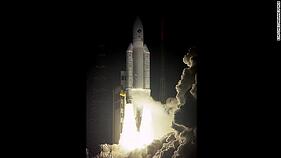
SilcoTek® coatings are used wherever high durability, inertness or improved material performance is needed. Our coatings can be found miles below the earth or millions of miles above us. Two space bound projects were recently in the news.
Rosetta wakes up!
CNN reported the European Space Agency mission, Rosetta, recently woke up from a several year slumber. Rosetta's mission is to intercept, monitor, and analyze the comet 67P/Churyumov-Gerasimenko . The SilcoNert® 2000 coated sampling instrumentation is designed to analyze the comet nucleus. The mission states:
"The instrument is designed for the in situ chemical analysis of a cometary nucleus as the details of the nucleus composition are of primary importance for understanding both the formation of the solar system, and the origin of life on Earth."
Not too shabby a project to be a part of!
SilcoTek coatings are the only inert material able to stand up to the demands of deep space while maintaining superior inertness and performance.
Why ESA chose SilcoNert 2000:
- Most inert
- High durability
- Able to withstand extreme hot and cold
- Won't flake or degrade over time
ESA goes on to state:
"Rosetta will be the first spacecraft to orbit a comet and to place a lander on the surface as it approaches and then swings around the sun."
"With these firsts it will enable us to make a quantum leap in our understanding of comets -- where they come from, their consistencies."
SilcoTek's unique process enables users to coat the entire analyzer sample pathway; including:
- Tubing
- Fittings
- Regulators
- GC components
- Pyrolysis components.
- MS components
The ESA describes some of the complex systems SilcoTek coatings improved: "The COSAC experiment consists of an evaporation/pyrolysis device and two analytical systems: a multi-column gas chromatograph and a high-resolution time-of-flight mass spectrometer which may either be operated alone or in a coupled mode."
Read about the incredible chromatography in this instrument!
NASA's Mars Rover in Action

Meanwhile Mars Rover Curiosity continues to.. well...be curious.. & learn more about Mars and potential/previous life on the planet.
A recent CNN article states:
"Since landing in Gale Crater, Curiosity has helped scientists determine that an area called Yellowknife Bay was habitable in ancient times.
Here, from the rim of the crater came stream waters that formed "a lake-stream-groundwater system that might have existed for millions of years," John Grotzinger, lead scientist on the Curiosity mission, wrote in last month's edition of the journal Science."
Read the complete article.


